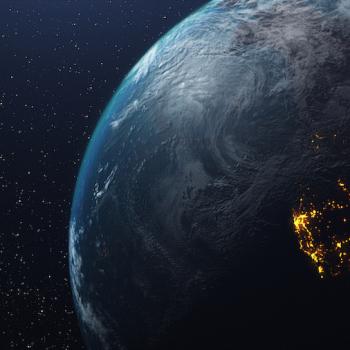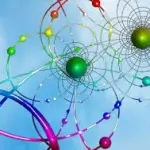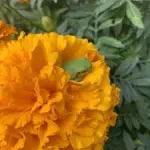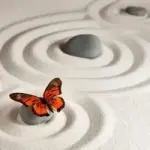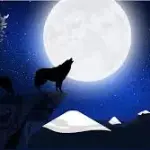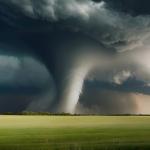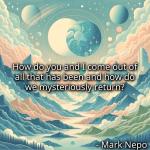If we surrendered to earth’s intelligence, we would rise rooted, like a tree. – Rainer Maria Rilke
In my last article, “The Place of Nature in Naturalist Spirituality – Part I,” I began exploring how nature provides much of the narrative and practical contexts for many spiritual naturalists.
As naturalism has become increasingly influential, explicitly and implicitly, in the culture, many are leaving supernatural forms of religion behind because they no longer make sense and are simply untrue.
For religion/spirituality to be authentic and have the power to improve human lives, it must be centered on the truth — not elaborate, ungrounded theology or grand speculation without foundation.
Our religious thinking should conform to the fullest sense of the truth we can muster. And that truth can no longer accommodate propositions of deities, spirits, miracles, and other supernatural claims.
The longing for a heavenly, otherworldly paradise is a longing not to be human. ― Milan Kundera
As people turn away from prayer, praise, and hymns to God, many still feel the natural inclination toward wonder, awe, gratitude, and the search for meaning. As people move beyond the eucharist, baptisms, and other forms of liturgy, many still see value in some form(s) of personal practice and even ritual.
Does nature itself inspire any forms of personal practice? What disciplines, rituals, and practices align with various expressions of spiritual naturalism?
Gladly, there’s no need to reinvent the wheel. Every week on our website, we read articles and participate in discussions where people share their ideas and advice on meditation, time in nature, reading and personal study, and service to others.
If we step back and reflect on the various suggestions, we start to get the sense that the practices of those who claim spiritual naturalism as their own aim at creating healthy, balanced, and harmonious relationships between self, other humans, other life forms, and nature itself.
Naturalist Spiritual Practices Aimed at Wholeness
Here are some suggestions based on my own experience and listening to the experiences of others:
Ritual: repeated actions of significance made to convey meaning. Often rituals are used to make mythic narratives concrete and part of the present moment. Other times, ritual is used to alter consciousness, open awareness, direct focus, and challenge our hearts and minds, consciously and unconsciously.
Rituals need not be held in churches or religious buildings and be led by clergy. Family Sunday dinners are a ritual. Putting up a Christmas tree is a ritual. Making certain foods for certain occasions is a ritual. Singing Happy Birthday with cake and candles is a ritual. Our lives are filled and punctuated by rituals.
Spiritual naturalists are free to explore and create their own. Candle lighting, meditation, celebratory meals, storytelling, and poetry reading — these, and other common activities can be augmented to create meaningful rituals for personal, family, and community use.
Mindfulness: cultivating awareness of our lives and striving to live fully, rooted in the present moment and within the larger ecosystem itself. Various forms of meditation can be valuable tools in aiding mindfulness.
Time in Nature: growing evidence abounds that time in nature — be it a forest or wooded area, a field, by water or a beach — away from human developments — is healing, promotes proper mental and physical functions, releases beneficial hormones, neurochemicals, and restores the soul.
Sustainability: working to restore and maintain ecological wholeness — establishing the right relationships between people and between people and nature.
Justice: maintaining proper relationships by giving others their due, including non-human life, and respecting and promoting the fundamental rights of all living things.
Simplicity: recognizing what is vital and what is extraneous and ordering our efforts and priorities accordingly. Simplicity can go a long way toward addressing the pervasive consumerism of our day.
Loving Kindness: striving to love our neighbor as ourselves, welcome the stranger, care for the needy, draw in the marginalized, and promote generosity, love, and compassion in the world.
Reducing Suffering: seeking to reduce and eliminate suffering and illness wherever possible, both among humans and animals.
Seasonal Celebrations
Personal practices and rituals often go hand-in-hand with celebration. And humans have a deep-seated need to celebrate life, achievements, themes, and even the seasons.
Back in the late 1990s, when my own spiritual rethinking and exploring began, I came across the Wheel of the Year, a modern hybrid of mostly European, pre-Christian, nature-based holidays focused on the turning of the seasons.
The Wheel and paying attention to the seasons and liminal times in between each, resonated with me then, and remains with me now. In fact, I have a decorative rendition of the Wheel prominently displayed in my home.
Following the rhythm of nature through the seasons offers a way of understanding what it means to be human and recognizing our inherent place in the ecosystem and the world.
There are several versions of the Wheel, and the dates and names vary from tradition to tradition, and in geographical areas where the seasonal shifts differ. Regardless of the differences, the seasons can provide a meaningful, natural touchpoint for celebrations.
My version of the holidays below can be simply celebrated with a shared meal with friends, family, and loved ones. It’s also easy to add seasonal appropriate décor, special readings or poetry, particular music, or perhaps a shared activity or craft — all of these can play a role in our celebration.
Holidays of Nature
The deep structure of these celebrations is nature and its cycles and rhythms. The specific timing of the holidays and festivals may vary due to culture and geographical location, but the cycles of the sun and seasons, and the corresponding agricultural events are the basis and structure for many of our enduring holidays.
Here, in the early years of the twenty-first century, most of us aren’t farmers, raise our crops, or slaughter our food. Despite our lack of immediacy, many of us, in fact, still celebrate semblances of these ancient festivals, albeit in disguised form – Christmas near the winter solstice, Easter in the springtime, and Rosh Hashanah in autumn, are just a few examples. The festivals remain, but gone is the direct sense of participation in the cyclic energies of the earth.
Attuning to the natural rhythms of nature can reconnect us to our place in the ecosystem. And there is growing awareness that we as a culture benefit from re-rooting ourselves in traditional celebrations corresponding to harvest cycles, solstices, equinoxes, sun cycles, and even the phases of the moon.
There is a pattern to life — birth, growth, decline, death, and rebirth. Nature unfolds on the unending wheel that turns through time in a similar fashion. The enduring cycles of nature are the drama of life and death. These patterns and cycles are universal and experienced by all. They transcend tradition, culture, or worldview.
Below is my own version of the Wheel of the Year – holidays and celebratory suggestions based on the progression of the seasons in much of the northern hemisphere.
October 31 – The Harvest Gathering – All Hallows
Many Northern European cultures celebrated final harvest time near the end of October as the New Year – the closing of the agricultural year taking precedence over the coming end of the modern calendar year. In many northern places, the harvest(s) are underway or just over and winter is quickly approaching. It seems fitting to contemplate themes of life and death and weigh the results of the year gone by as winter approaches.
December 21 – Winter Solstice
It’s hard to not want to celebrate the return of the light and lengthening days amid darkness and cold. Regardless of what you call this time of year, it seems appropriate to mark the season with gatherings of light, love, community, and joy. It is a slow, inward time of year, a season of reflection and recharging, but also of hope for the year ahead.
February 15 – Winter Waning
As winter for some reaches a midpoint, while for others begins to fade, many contemplate simplicity. This season has traditionally meant preparation for spring and clearing away winter debris for many ancient cultures. In modern times, it can be used to rid our lives of that which hinders our progress, happiness, and health. It’s a natural time to reflect on simplicity and an occasion to reflect and rest in nature’s stillness.
March 21 – Spring Equinox
Nature stirs with awakening energy. As farmers begin prepping the soil for planting, we too can reflect on our goals for the year and take the needed action. As we shake off winter, many meditate on the new life emerging, on renewing health, and on questions of balance.
May 1 – May Day
Early summer marks the start of the bright, warmer half of the year. It’s time to celebrate nature’s creativity and begin implementing our main projects and plans for the year. Fertility is also a theme of this holiday — the beauty and sensual regenerative power of life and nature are becoming abundant now.
June 21 – Summer Solstice – Midsummer
The sun is at its high point for the year and things are coming into full bloom. The days are bright and at their longest. With energy running high, it’s a great time to tackle projects and throw ourselves into making progress on our plans and goals. It’s also a great time to throw a festive dinner outside in the sun or to celebrate on the longest evening of the year.
August 15 – First Fruits
In the middle of August, the earth is alive in full splendor, bearing fruit and with crops tall and robust. Preparation for the first harvest will soon be underway and it’s an ideal time for examining our efforts for the year thus far. Take time to appreciate nature’s abundance and celebrate the remaining days of summer with friends and family as the season wanes.
September 23 – Autumn – Harvest Home
The start of autumn and the celebration of the turning of the year, as the shadows lengthen, we sense the slowly fading energies of summer, but also rejoice in the soon-to-emerge splendid colors. It is a time for giving thanks, taking stock of our lives, and cultivating gratitude. We reflect on the harvest of our own lives and reassess our projects and goals — what have we accomplished as the year begins to close?
The above ideas are my own interpretations and renderings. Feel free to adjust any of it to fit your own situations.
What holidays and celebrations are meaningful to you? I’d love to hear, please share in the comments below.
__________
Subscribe to The Spiritual Naturalist Society
Learn about Membership in the Spiritual Naturalist Society
The Spiritual Naturalist Society works to spread awareness of spiritual naturalism as a way of life, develop its thought and practice, and help bring together like-minded practitioners in fellowship.
SNS strives to include diverse voices within the spectrum of naturalistic spirituality. Authors will vary in their opinions, terms, and outlook. The views of no single author therefore necessarily reflect those of all Spiritual Naturalists or of SNS.





